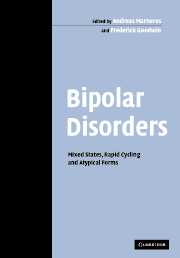Book contents
- Frontmatter
- Contents
- List of contributors
- Preface
- 1 Bipolar disorders beyond major depression and euphoric mania
- 2 Emerging concepts of mixed states: a longitudinal perspective
- 3 Rapid-cycling bipolar disorder
- 4 Bipolar I and bipolar II: a dichotomy?
- 5 Recurrent brief depression as an indicator of severe mood disorders
- 6 Atypical depression and its relation to bipolar spectrum
- 7 Agitated depression: spontaneous and induced
- 8 Schizoaffective mixed states
- 9 Acute and transient psychotic disorder: an atypical bipolar disorder?
- 10 Bipolar disorder in children and adolescents
- 11 Atypical features of bipolarity in old age
- 12 Comorbidity in mixed states and rapid-cycling forms of bipolar disorders
- 13 Challenges in the genetics of bipolar disorder
- 14 Biological aspects of rapid-cycling and mixed states
- 15 The treatment of bipolar mixed states
- 16 The use of atypical antipsychotic agents in the treatment of diagnostic subgroups of bipolar disorder: mixed and pure states, psychotic and non-psychotic
- 17 Investigational strategies: treatment of rapid cycling, mixed episodes, and atypical bipolar mood disorder
- Index
- References
6 - Atypical depression and its relation to bipolar spectrum
Published online by Cambridge University Press: 10 August 2009
- Frontmatter
- Contents
- List of contributors
- Preface
- 1 Bipolar disorders beyond major depression and euphoric mania
- 2 Emerging concepts of mixed states: a longitudinal perspective
- 3 Rapid-cycling bipolar disorder
- 4 Bipolar I and bipolar II: a dichotomy?
- 5 Recurrent brief depression as an indicator of severe mood disorders
- 6 Atypical depression and its relation to bipolar spectrum
- 7 Agitated depression: spontaneous and induced
- 8 Schizoaffective mixed states
- 9 Acute and transient psychotic disorder: an atypical bipolar disorder?
- 10 Bipolar disorder in children and adolescents
- 11 Atypical features of bipolarity in old age
- 12 Comorbidity in mixed states and rapid-cycling forms of bipolar disorders
- 13 Challenges in the genetics of bipolar disorder
- 14 Biological aspects of rapid-cycling and mixed states
- 15 The treatment of bipolar mixed states
- 16 The use of atypical antipsychotic agents in the treatment of diagnostic subgroups of bipolar disorder: mixed and pure states, psychotic and non-psychotic
- 17 Investigational strategies: treatment of rapid cycling, mixed episodes, and atypical bipolar mood disorder
- Index
- References
Summary
Introduction: the relationship of atypical depression to bipolar II disorder
The focus of this chapter on the relationship between atypical depression (AD) (different definitions, including Diagnostic and Statistical Manual of Mental Disorders, 4th edn (DSM-IV): (American Psychiatric Association, 1994) definition) and bipolar (BP) spectrum is the relationship between BP-II and AD, because BP-II is the most common and best-studied disorder of the BP spectrum disorders. BP-II was recently found to be very common in the community (11.0% BP-II versus 11.4% unipolar (UP): Angst et al., 2003) and in major depressive episode (MDE) outpatients (up to 60%: Cassano et al., 1992; Angst, 1996; Benazzi, 1997a, 2001a; Hantouche et al., 1998; Perugi et al., 1998; Akiskal et al., 2000; Benazzi and Akiskal, 2003a). But nevertheless BP-II is still underdiagnosed (Ghaemi et al., 2000). Lumping bipolar-I (BP I) and BP-II together is not supported by the BP-II strong diagnostic stability (Coryell et al., 1995), different family history (more BP-II than BP-I in first-degree relatives of BP-II) (Goodwin and Jamison, 1990; Coryell, 1999), and by linkage studies (McMahon et al., 2001).
The most recent definitions of BP spectrum come from Akiskal and Pinto (1999), Ghaemi et al. (2002), and Angst et al. (2003). Akiskal and Pinto's definition includes BP-I, BP-II (hypomania and MDE ± cyclothymic disorder), BP-III (antidepressant and stimulant-associated hypomania), and BP-IV (depressive mixed state, that is, a MDE plus some concurrent hypomanic symptoms).
- Type
- Chapter
- Information
- Bipolar DisordersMixed States, Rapid Cycling and Atypical Forms, pp. 131 - 156Publisher: Cambridge University PressPrint publication year: 2005
References
- 1
- Cited by

